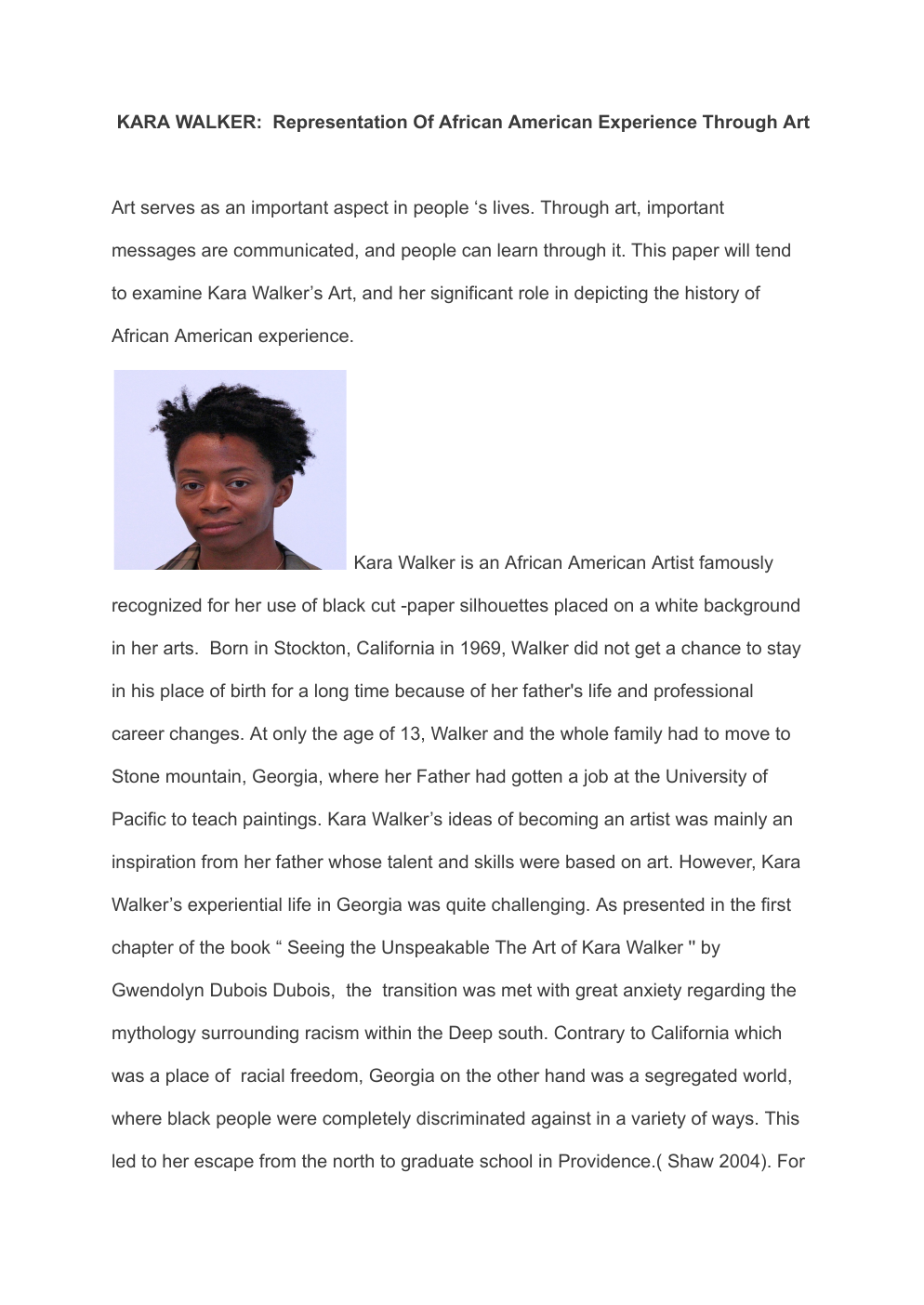KARA WALKER: Representation Of African American Experience Through Art
Publié le 24/09/2023
Extrait du document
«
KARA WALKER: Representation Of African American Experience Through Art
Art serves as an important aspect in people ‘s lives.
Through art, important
messages are communicated, and people can learn through it.
This paper will tend
to examine Kara Walker’s Art, and her significant role in depicting the history of
African American experience.
Kara Walker is an African American Artist famously
recognized for her use of black cut -paper silhouettes placed on a white background
in her arts.
Born in Stockton, California in 1969, Walker did not get a chance to stay
in his place of birth for a long time because of her father's life and professional
career changes.
At only the age of 13, Walker and the whole family had to move to
Stone mountain, Georgia, where her Father had gotten a job at the University of
Pacific to teach paintings.
Kara Walker’s ideas of becoming an artist was mainly an
inspiration from her father whose talent and skills were based on art.
However, Kara
Walker’s experiential life in Georgia was quite challenging.
As presented in the first
chapter of the book “ Seeing the Unspeakable The Art of Kara Walker '' by
Gwendolyn Dubois Dubois, the transition was met with great anxiety regarding the
mythology surrounding racism within the Deep south.
Contrary to California which
was a place of racial freedom, Georgia on the other hand was a segregated world,
where black people were completely discriminated against in a variety of ways.
This
led to her escape from the north to graduate school in Providence.( Shaw 2004).
For
Kara Walker, Rhode Island School of Design provided her with significant source
material regarding race and racism.
“She read a number of books like bell hooks,
Michelle Wallace, looking at reference bookls on early american painting and
portraiture and twentieth century works by black artists.
By the mid-1990s, she had
found an exciting medium in the form of the silhouette” (Shaw 2004, Page 13).
Kara
walker’s thoughts about her art based on exploring the issues of race, gender and
class struggles withing the slavery in the United States, especially in the Antibellum
South came from her own experiences living in such a racisist area with her family.
The artist Kara Walker was first recognized for her first exhibition of her work of
sculpture, “ A subtlety, or the Marvelous sugar baby” in May 2014.
Like she
mentioned in her interview, Thinking about this activity, Kara Walker had so far read
the long history of Sugar in the East and the West, how it became a European
Delicacy and had a different cultural and social meaning.
She wanted to connect
sugar production to the centuries of slavery in America.
It became her first reference
point to comment on power, race and racism issues in the US.
.
The use of silhouette was one of her most successful projects , as it attracted the
world in a variety of ways.
Walker began working in silhouette form after a master’s
degree from Rhode Island School of Design while exploring themes of slavery,
violence, and sex found in sources such as books, films and cartoons.
The
inspiration for Kara Walker in such a technique was from observing the surface of
things: Black, “Negro, Images, and objects.T”( Shaw 2004, page 12).
This technique used by Kara Walker made her gain
outstanding recognition in history, and became the first African American young artist
to be awarded a higher award.
One of them is the MacArthur Foundation Fellowship
in 1997 at only 27 years old( Sarah 2014).
Nevertheless, while she has won prestigious awards internationally, her work
provoked countless criticisms of manyAfrican American artists and scholars from
time to time.
As Sarah Mentioned in her analysis, Artists such as Betye Saar and
Howardener Pindell accused her of perpetuating racist ideologies and insensitively
mocking the history of suffering endured by slaves.
“The attack was directly not only
her art, but several scholars and artists also attacked her personally and accused
her of exploring racist imagery for the financial gain within the white-dominated art
world”.( Sarah 2014, page 14).
According to the letter by Saar in 1997, Walker’s
work had no other intention than her own profits, not a spirit of overcoming racial
oppression.
In 2009, an artist Hawanden Pendel also organized critics....
»
↓↓↓ APERÇU DU DOCUMENT ↓↓↓
Liens utiles
- African American
- I. M. Pei's Louvre Pyramid - art. Chinese-born American architect I.
- American Gothic - - art.
- Maya Angelou Maya Angelou, born in 1928, American author, poet, performer, and civil rights activist, best known for portrayals of strong African American women in her writings.
- Martin Scorsese Martin Scorsese, born in 1942, American motion-picture director, whose best films have reflected the Italian American experience of his childhood in New York City's Little Italy neighborhood.









